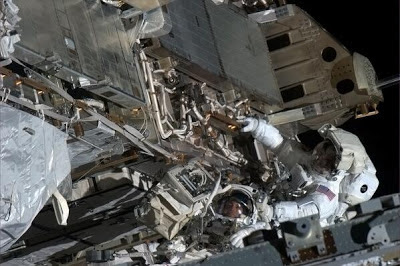 |
| Spacewalkers Cassidy and Marshburn conducted a 5 and a half hour EVA |
Canadian Space Agency astronaut and Space Station Commander Chris Hadfield acted as today's Intra-Vehicular Crew Member, supporting Airlock Ops and choreographing the EVA from inside
The main aim of the EVA was for Marshburn and Cassidy to exit the space station's Quest Airlock
in their space suits to inspect and possibly replace the pump leaking the ammonia.The EVA began at 1:44 p.m. GMT as the station flew 255 miles over the Sahara Desert.
Marshburn and Cassidy quickly got to work, translating the 150 feet along the station's Port truss in order to reach today's work site. At first, the pair didn't spot anything out of the ordinary, and little or no sign of the ammonia leak. "I see nothing off nominal" said Cassidy. As is the case with pretty much every spacewalk, the crew ran into some minor problems with bolts early on, but this was quickly overcome. Like a pair of tourists, Marshburn and Cassidy constantly took photo after photo of the work site in order to assist teams on the ground on the the condition of the area, and will also aid teams when future EVAs are conducted on the P6 Truss.
 |
| The old PFCS box(yellow) was replaced by a new, clean box(red). credit: NASA |
After overcoming problems with the flash on his camera, Marshburn continued to work alongside Cassidy in unbolting and removing the PFCS box in order to identify the source of the leak. No ammonia flakes were spotted by either astronaut, after initial inspection, not exactly what you want to hear when looking for a leak. The decision was then taken to replace the suspect box with a spare one located nearby. If all this information is too much for you, look at this picture- it might help explain it a bit better.
After the spare box was installed, the system was turned on in order to allow ammonia to flow into the station's cooling lines. After this procedure was initiated, keen eyes from Mission Control watched closely to see how the new Subsystem was performing, and also to look out if any ammonia began to leak out of it. Shortly after instillation, the moment of truth arrived, as the ammonia from the pump began to flow, recharging the coolant system in the process, with no leak visible.
A little over three and a half hours after the beginning of the Extra-Vehicular Activity, Marshburn and Cassidy declared that they had completed all the tasks they set out to achieve. The pair then were ordered to stay outside in the vacuum of space for a little while longer,in a process known as "Bake-Out"- in which Cassidy and Marshburn got rid of any ammonia contamination that may have gotten onto their spacesuits while working out at the Station's P6 Truss structure.
 |
| Cassidy and Marshburn take a quick timeout to pose for a photo during the EVA credit: Chris Hadfield/NASA |
Today's activities outside were brought to a close when the hatch to the Quest Airlock was closed at 7:14 p.m. GMT. The astronauts spent a total of 5 hours and 30 minutes outside and all in all, the spacewalk and repair could not have gone any better, with Marshburn and Cassidy finishing their excursion one hour ahead of schedule. It is still unclear at this present time what originally caused the ammonia leak, but seeing that no leak or flakes were visible after the new PFCS was installed, the old pump seemed to be the cause of the problem. Official confirmation of the source of the leak may take days, if not weeks to figure out.
Now all attention turns to the return of the Soyuz-TMA 07M spacecraft to Earth, carrying Chris Hadfield, Roman Romanenko, and today's spacewalker and space plumber Tom Marshburn after nearly six months in space. They are expected to make a parachute assisted landing in Kazakhstan at 3:30 a.m. GMT on Monday May 13.
Another seven EVAs are scheduled for this year, two of which will involve today's spacewalker Chris Cassidy. He will be accompanied by Italian astronaut Luca Parmitano, who will launch to the station on May 28.
More to follow...

Now all attention turns to the return of the Soyuz-TMA 07M spacecraft to Earth, carrying Chris Hadfield, Roman Romanenko, and today's spacewalker and space plumber Tom Marshburn after nearly six months in space. They are expected to make a parachute assisted landing in Kazakhstan at 2:30 a.m. GMT on Monday May 13.
ReplyDeleteHey Maciej,
DeleteThanks for reading and also for your comment!
On the NASA website it says landing is scheduled to take place south east of Dzhezkazgan, Kazakhstan scheduled for around 10:30 p.m. ET which equals 3:30 a.m. GMT
I guess we'll just have to wait and see!
Thanks again!